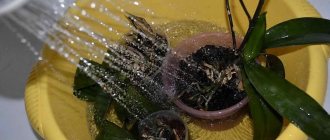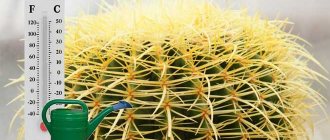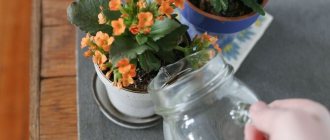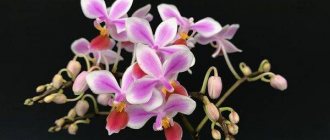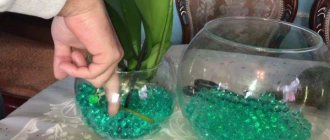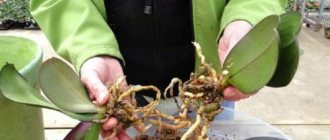- September 15, 2018
- Flowers
- Yulia Saltrukovich
The phalaenopsis orchid is one of the favorite and most common indoor plants that requires virtually no care. Sufficient lighting, optimal indoor air humidity and proper watering - perhaps this is all you need for a comfortable life. However, many people think about how to water phalaenopsis. Which watering method should I choose and how often should I do it? Let's try to find answers to these questions together.
Phalaenopsis
This variety of orchids is an amazing plant, the distinctive feature of which is its unusual root system. Airy and powerful, in nature it is attached to tree roots, snags and other supports. At home, a special air substrate is prepared for orchid roots, which allows the roots to breathe and absorb all the necessary substances directly from the environment. This is why it is so important to water phalaenopsis correctly. How to do it? You will learn the answer to this question from the article.
There are several watering methods, each of which will provide the plant with the necessary amount of moisture. You can water it using the usual method, you can immerse the roots of the plant in water, you can offer the orchid a shower. Some people prefer a “passive” watering method, leaving small ice cubes on the surface of the substrate.
The importance of orchid irrigation
The universal solvent for minerals and other nutrients is water. Therefore, its regular supply is, without exaggeration, vital for plants.
Since it is impossible to obtain moisture naturally at home, flowers need artificial watering. Moreover, each specific culture requires an individual regime.
Phalaenopsis is a tropical orchid. This circumstance gives many inexperienced collectors reason to believe that it requires a large amount of moisture. The conclusion is completely wrong.
In reality, the plant tolerates short-term overdrying of the substrate much more easily than its constant soaking. The latter is the main cause of rotting of the root system, which ultimately leads to the death of phalaenopsis.
Our orchid belongs to the group of epiphytes, that is, in its natural environment it lives on tree trunks, stumps, etc. Accordingly, as a result of evolution, the flower has developed the ability to live without soil at all. The roots of the phalaenopsis remain open, they are wetted by rain, and then quickly dried by the breeze. Therefore, the lower part of the culture has acquired the ability to extremely effectively adsorb moisture (even that in the air). The flower itself knows how to spend it extremely economically.
Being in ordinary soil is a big problem for an orchid, so a special composition is used for it, which includes:
- pine bark (fine fraction - 10-20 mm);
- charcoal;
- dried sphagnum moss.
Such a substrate practically does not retain moisture and is only a support for the plant.
When should this be done?
Remember once and for all. So as not to think and wonder how to water phalaenopsis. You need to water the orchid only when its roots and substrate are completely dry. Moreover, the dried roots can calmly stand for a few more days - it definitely won’t get any worse. But you will definitely be sure that watering the roots now will definitely not harm them.
The speed of drying of the substrate is also important. The best option is when the substrate and roots dry completely within one day. This trend applies to all epiphytic orchids. A lot depends on the weather outside the window. On a hot sunny day, moisture can completely disappear within 24 hours. But in rainy weather or winter it takes much longer.
How often should the substrate be moistened?
The frequency of soil moisture depends on the following factors:
- From the composition of the substrate. Pay attention to the components of the soil for your orchid. For example, sand quickly absorbs moisture, but at the same time gives it away just as quickly, since sand does not have the ability to retain water. But clay soils do not absorb water well, but remain wet for a long time.
- From the level of air humidity. If air humidity is high, then reduce the frequency of watering.
- From the air temperature. If it is increased, then the soil will dry out faster and require more moisture.
- Depending on the time of year and the length of daylight hours. In summer, moistening occurs more often, weeks in winter. This is also due to the fact that during the cold season, orchids enter a period of rest.
- From the size of phalaenopsis. The larger the plant, the more moisture it will require.
- From the volume of the flowerpot. Larger pots will take up more moisture. But keep in mind that a small container may not hold the amount of water the plant needs. But in a large pot, on the contrary, moisture may be lost and not reach the root system in the required volumes.
- From the age of phalaenopsis. Every year the need for water increases. But after 8-10 years of age it decreases again.
What should you pay attention to?
It happens that even in the hot summer, phalaenopsis is in no hurry to dry out. This means it's time to change the substrate. A fraction that is too fine takes longer to dry, so it is worth replacing it with larger particles, which will also provide more free space for the roots.
If it is difficult for you to navigate the root system of a plant and you do not know how to water phalaenopsis, pay attention to the statistics. As a rule, in winter the orchid is watered once every two weeks. In summer - every 2-3 days. In spring and autumn, a single watering for seven days is sufficient. But this is conditional data. Each orchid behaves differently depending on the degree of light and air humidity.
If you are confused about how dry the substrate is and how to water your phalaenopsis, consider the following orientation methods.
general information
Watering Phalaenopsis is a very important aspect of flower care, because through it they receive nutrients. Orchids are epiphytic plants, that is, in nature they live on trees and other plants. Without being parasitic. Their roots are always in close contact with the air, from where they absorb moisture. Tropical rains constantly wash them. Approximately the same conditions are created in the apartment.
Of course, it is almost impossible to create tropics at home, but it is possible to bring the atmosphere as close as possible to such indicators. Before watering Phalaenopsis, learn to correctly determine the need for watering. This can be done in several ways.
Visual methods for determining watering
- The color of the roots that need watering is silver-green. As soon as the entire root system becomes this color, it is time to water.
- If the plant begins to wilt and looks drooping, then most likely it needs to moisten the soil.
- If condensation has formed in the pot, it is too early to water. If nothing like this is observed, then you can add water.
- If the pot's drainage system is completely dry or almost dry, then it's time to add water.
Touch test
- If the top surface of the soil is wet and damp, then it is too early to moisten.
- When the soil feels almost dry or completely dry, it is time to water.
Important! Watering is carried out in the morning. This will allow the soil to dry out until the evening and avoid rotting.
How do you know if a plant can be watered?
Here are some simple rules.
- Focus on the weight of the pot. Take it in your hand immediately after pouring it - fix its weight in your head. Do the same after a few days. If it has “lost weight” significantly, the phalaenopsis needs watering.
- Carefully remove the top layer of bark. If the next substrate is wet, there is no need to water the plant.
- Stick a wooden stick into the middle of the pot. And as soon as you want to water the plant, take it out and look carefully. If it is still wet, postpone watering for a few days.
- Use a transparent pot for the orchid. This way you can clearly assess the condition of the substrate and the degree of moisture in the roots.
How to determine that a plant needs moisture?
There are several options for this:
- Using your own finger. You need to dig a hole and place your finger in the soil to a depth of 4-5 cm. If you feel that the soil is still wet, then watering can be postponed for now.
- Wooden stick. If you don't want to get your finger dirty, any long thin piece of wood will do. Instead, you can use a toothpick or pencil. The principle of use is the same as in the previous case.
- Root color. Usually they are clearly visible among the earth clod. If the rhizomes have acquired a gray tint, then you should not delay with moisturizing.
- Flowerpot weight. This method is used most often by flower growers. Because it is simple and reliable. The principle is as follows: after watering, take the pot in your hands and remember its approximate weight. Periodically take the container in your hands and compare how much lighter it has become. If the mass is very small, then it’s time to start watering.
How many times a week do you water?
In summer, watering is carried out every 3-4 days. With the arrival of winter, the frequency of watering is reduced as much as possible: to twice a month. But in the intermediate periods (spring and autumn) the optimal regimen is once every seven days.
Attention! Try to water phalaenopsis in the morning.
If watering is too frequent, the plant will not have time to absorb all the moisture. As a result, the roots begin to rot. If most of the rhizomes begin to rot, the ability to absorb water is reduced to a minimum, as a result of which the plant dies.
When a plant feels a lack of water, it begins to shed parts of itself. He starts with the most insignificant for the culture - flowers. Then the old leaf plates dry out, then the young leaves and root system come. Due to the fall of the green part, the ability to carry out photosynthesis disappears. Because of this, the orchid does not receive the necessary nutrients.
How to water phalaenopsis at home?
The best way to water is to completely immerse the pot in a container of warm water. You can immerse the plant for 15-20 minutes in the warm season. In winter, five minutes is enough for the roots to receive the required amount of moisture. After this, you need to remove the pot from the water and allow excess liquid to drain. Watch this carefully so that there is no moisture left at the bottom - it can cause rotting of the roots.
By the way, this procedure is best performed in the morning so that the plant can dry completely by evening. There is one more point here - orchids are especially active in “drinking water” in the morning and afternoon. At night, the plant, like most others, falls asleep. If you wet the substrate in the evening, it will take longer for the roots to dry out.
How to save a plant?
- If the root system dries out, the plant should be moistened more often.
- If the roots begin to rot, stop moistening the soil for a while. And then maintain longer intervals between waterings.
- If improper care continues for a long time, then, most likely, it will not be possible to save the crop.
To destroy diseases and pests, give the phalaenopsis a hot shower. This manipulation is carried out in the bathroom. The flower is removed from the pot, held with one hand, and the roots washed with the other. To avoid burning the rhizomes, rely on your own feelings.
Proper watering is the key to healthy development and flowering of phalaenopsis. Therefore, observing the soil moisture regime is very important for the full development of the plant.
Shower for orchids
You can dramatically transform your plant if you know how to water phalaenopsis orchids at home. It is believed that a hot shower works wonders for many living creatures on earth. This rule also applies to orchids. True, it is necessary to separate the concepts of “shower” and “hot”. If everything is done correctly, they will not be afraid of any diseases, and they will begin to bloom even more beautifully.
A simple shower is good for phalaenopsis. For many other orchids it is undesirable. For example, hybrid Cambrias, “slippers” and Miltonias should not be watered. It is also important to choose the optimal temperature - it should not exceed 40 degrees. Unless, of course, you want to cook your plant.
How and what to contribute
Fertilizer should be mixed with water for irrigation. It is better not to use other methods, as they are noticeably less effective.
Stop feeding after the first bud opens. If this is not done, the flowers will not last long.
Use only complex preparations designed exclusively for orchids.
Chemicals
Not all purchased fertilizers are of sufficient quality, for this reason it is worth choosing them carefully.
A very good option is GreenWorld. The drug is liquid, it is designed to strengthen the root system, stem and foliage.
“Bona Forte” is a fairly high-quality multi-component mix that helps the plant:
- prolong flowering;
- strengthen immune defense;
- lengthen life;
- activate photosynthesis.
This product is especially recommended for those collectors in whose homes it is difficult to create ideal conditions for phalaenopsis.
"Kemira-lux" - complex feeding. Sold in powder form. It contains a particularly high amount of nitrogen, but this deficiency is compensated by the following properties:
- acceleration of development;
- stimulation of immunity;
- general improvement in the condition of the flower.
Liquid concentrated fertilizer "Pokon" is versatile. It is allowed to be given at all phases of orchid growth. It helps prolong flowering, strengthen the green mass, and enhance the intensity of its color. The drug is easily absorbed by phalaenopsis.
From the list of biologically active agents, “Baikal EM-1” and “Epin” should be highlighted. The first contains several strains of beneficial bacteria and yeast cultures, while the second is a natural stimulant.
Folk
Alternative options are numerous, but less effective. So, you can use onion peel tincture quite safely.
Take about a handful of raw materials and pour 2 cups of boiling water. Let cool and wait 2 days. Apply the finished product diluted with water (1 to 10) during watering.
Potato broth has proven itself quite well. Wash the tubers and cook without peeling. Cool the liquid to +35°C and pour into the pot.
An infusion of wood ash helps not only to feed the orchid, but also to eliminate the consequences of using hard water. Take 3-4 tbsp of powder. Pour a liter of boiling water. Wait a day and use for watering at least three times.
Organic is also quite popular. The most commonly used is manure or bird droppings. Their disadvantage is their slow action. The thing is that the components of the mentioned fertilizing must still be treated with bacteria - only after that the plant can assimilate them.
It is not recommended to apply organic products more than once every six months.
For the formation of buds
To get the desired effect, fertilizer should be applied approximately 7-15 days before the ovaries appear. When they occur, nutrients are withdrawn.
Feeding is applied as follows:
- Water the orchid moderately;
- mix the drug with water according to the attached instructions;
- immerse a flower pot in a container with a solution;
- after 5 minutes, remove;
- wait until excess moisture drains out;
- return to its usual place.
In progress
When phalaenopsis opens its buds, it is important not to overfeed it. Give the products only when absolutely necessary and highly diluted (three times the usual amount).
Before applying the drug (1-2 hours before), water the orchid. Then place the culture in a container only slightly larger than the pot. Fill all free space with a nutrient solution.
After 7 minutes, remove the flower and return it to the windowsill.
Tip: When buying fertilizer, always look to see if potassium is in the list of ingredients. This substance is very necessary for orchids.
After completing the phase
When the petals fall, feed them in the same manner as described earlier for at least another 7 days. This will allow the phalaenopsis to quickly restore its supply of vitality.
It is during this period that it is most effective to use “Baikal EM-1” or other biological preparations.
Having figured out how to properly water a phalaenopsis orchid directly at home, you can provide it with optimally comfortable maintenance. The flower will live a long time and will delight you with its healthy appearance for years.
What do you need to know?
After a shower, be sure to blot all the “secluded” places of the orchid with a dry napkin. Accumulation of moisture in the rosette or between the leaves can lead to rot. All leaf sinuses and the growing point itself deserve close attention.
Never water a dormant plant in the shower. As a rule, this is the autumn-winter period.
Why is it important?
The phalaenopsis orchid comes from tropical forests, so proper watering is extremely important for it. It is recommended to follow a certain frequency of watering that suits the plant. This is important, because if not cared for properly, the plant will feel unwell, may get sick or even die. From the point of view of Feng Shui, diseased plants take away the energy of their owners and bring negativity and misfortune.
What determines the frequency of watering at home?
To determine the frequency of watering a plant, you need to consider several factors:
- Age, size and condition of the plant.
- Season.
- Climate indoors and outside.
- Volume of the pot (read about how to choose the right pot for phalaenopsis here).
- Moisture capacity of the substrate (you can find out what the soil should be like for growing phalaenopsis orchids here).
What water should I use for irrigation?
This question is also of no small importance. You know very well what kind of water flows from our taps. You can imagine what it can do to such a delicate plant as an orchid. Water intended for irrigation must be clean and soft. You can filter it and boil it in advance. These methods allow you to purify water from various impurities that are harmful to the fragile plant. Many people use distilled water for irrigation.
By the way, it is precisely this that is the ideal option for watering the plant, since it does not contain pathogenic impurities and heavy metals. But at the same time, it does not contain microelements and salts necessary for normal plant growth. Therefore, if you prefer to water your phalaenopsis with distilled water, keep in mind that the orchid needs microelements, which can be added along with fertilizers.
Temperature and quality of water for watering orchids
There is an opinion that a hot shower has a beneficial effect on the health of orchids. This procedure can indeed be useful for non-blooming orchids if carried out in the summer and with slightly warm water, but it is not useful for all types of showers.
For example, some hybrid Cambrias, Miltonias and Lady's slippers should not be irrigated this way. Regular watering is carried out with slightly warm water at any time of the year. Cold water causes temperature shock and increases the risk of disease.
The main mistakes in caring for orchids
And one more important rule - after a shower, you need to blot with a paper napkin all the places where water could get, especially the center where the growing point is and all the leaf sinuses.
Also important is the quality of water, which should be soft (free from calcium) and clean. Hard water leads to salinization of the substrate, which negatively affects the health of the plant.
The ideal option would be rain or melt. You can boil pre-filtered water to soften and remove any impurities. Distilled water is also used, both separately and in a mixture with ordinary settled water in a 1:1 ratio.
How to make an orchid bloom again - 2 ways
However, it is not recommended to water with distilled water alone, since it lacks all useful salts and trace elements. You can water with settled tap water, but this requires annual replanting with replacement of the substrate without increasing the size of the pot.
Phalaenopsis, watered with hard water with a high salt content, becomes covered with white or red spots and plaque. Now look at the roots of your orchid.
Rusty color of phalaenopsis roots - hard water for irrigation
If you notice such a plaque, try washing it off with milk or something sour - kefir, water and lemon juice, and then plant the plant in a new substrate.
Author: Irina Baltaga Updated: December 14, 2020
- All about orchids
Comments
Tanya 01/03/2015 10:45 Finally a good article and to the point!! Thank you very much!
Answer
Darina 03/15/2016 21:28 Thank you very much, your article helped me deal with very important issues with:
Answer
Milla 12/03/2016 20:03 Thank you! Very good article!
Answer
Ksenia 12/25/2018 15:49 Thanks for the article! Pleasant style and useful information.
Answer
Update list of comments
How to water a blooming orchid?
As soon as you notice young buds, you need to completely reconsider the plant’s watering regime. You need to create all the necessary conditions for your orchid to turn from a nondescript stem with spreading leaves into a beautiful flower that pleases the eye.
During the flowering period, phalaenopsis produces seeds. They are very small and barely noticeable. Volatile, they can travel several kilometers from their birthplace. In nature, when the rainy season begins, the seeds cannot fly long distances. Therefore, it is advisable to adhere to the following irrigation mechanism:
- You only need to moisten the roots of the plant, trying to saturate them as much as possible with moisture, but not drown them.
- If the air in the room is too dry, you can spray the leaves with a sprinkler, but do not touch the secluded places of the plant. If this does happen, remove excess moisture with a dry cloth.
- During flowering, the orchid also needs to be watered as the substrate dries. As a rule, this is once a week.
In the autumn-winter period, phalaenopsis “falls asleep”, so it needs less moisture. Optimal regimen: once every 10 days or two weeks. It is not necessary to adhere to such strict rules. If your apartment is warm and humid enough, you can provide watering much more often.
Watering frequency and water indicators
Proper watering depends on several factors. The first is necessity. This has already been said. On the other hand, the right solution would be to create a schedule that will allow the flower to quickly adapt to the conditions of an apartment or greenhouse. The following factors are taken into account:
- Season. In the warm season, the frequency of watering doubles, because the rate of evaporation of water from the soil increases along with the rise in temperatures outside and in the house.
- Internal heating. In winter, heating devices operate in apartments and premises, which greatly dry the air and quickly evaporate water from the substrate. At this time, it is best to check using visual and tactile methods.
In general, in winter it will be enough to water your pet approximately once every 7-20 days, and in summer 2 times a week.
Important! The frequency of watering is directly related to the individual conditions of the plant. The main role is played by humidity and temperature in the room. They are monitored using a psychrometer.
What to do with a potted plant immediately after purchase?
Many people make a catastrophic mistake when they buy a new orchid and immediately begin to remake it in their own way (change the pot, remove excess roots, water, etc.). This cannot be done. Phalaenopsis grew calmly in familiar conditions, where there was optimal air temperature and humidity, but now its living conditions have suddenly changed. It is clear that the plant is under stress. Therefore, he needs to undergo a short quarantine.
It consists of protecting the orchid from other plants and direct sunlight. In addition, it is recommended not to water it at all for one week. This is necessary in order to identify pests and destroy them in a timely manner. 5 days after purchase, you can begin to accustom the orchid to new living conditions, giving it the opportunity to bask in the sun’s rays and providing moderate watering.
Please note that after transplantation, phalaenopsis cannot be watered for two weeks. In winter, it is not advisable to spray the leaves of the plant with water - this can lead to hypothermia. Now you know how often to water phalaenopsis. All that remains is to wish you success in caring for this beautiful plant!
Features and nuances of the procedure
There is no single watering standard for orchids. There are separate nuances and rules in each individual case.
For non-standard cultivation
If you receive a specimen that has few roots or no root system, then do not worry. Such a plant can be revived. An orchid with a small number of living roots is planted in a small container.
Attention! Instead of watering, use fine-drip irrigation of the top layer of the substrate, or place the container with the orchid in a tray with a small amount of water for half an hour. The soil should be moistened again only after it has completely dried. With such care, new root growth should be expected within a couple of weeks.
When transplanting
After transplantation, phalaenopsis needs time to get used to the new conditions. Therefore, you do not need to water it right away. If planting took place in dry soil or in the summer season, then watering can be done after 24 hours. In winter, you need to wait 2-3 days, and only then saturate the transplanted phalaenopsis with moisture.
In case of insufficient air humidity
In nature, in the habitat of orchids under the canopy of tropical forest trees, air humidity reaches 90% -100%.
It is not possible to maintain such high indicators in an apartment. However, too dry air is harmful to phalaenopsis. Especially in winter, when the central heating radiators work hard. In this case, in addition to regular watering, you need to use a spray bottle around the orchid from time to time. A special air humidifier device will also help solve this problem.
With supplements
In order for the plant to actively bloom and develop, you need to use special nutritional supplements.
Reference. Phalaenopsis is fed only after watering in order to preserve the plant’s root system. Sometimes fertilizing can be combined with watering. Solutions for this can be easily prepared at home.
For example:
- Sugar water helps weakened specimens recover well. Use one spoon of sugar per liter of water, this serves as an excellent source of energy.
- An effective fertilizer is garlic water. The main thing is not to overdo it with fertilizer. You cannot use fertilizer with every watering, this will lead to the death of the plant.
- For 1 liter of water – squeeze out 1 clove of garlic through a press. The water must be at least +35 degrees.
- The resulting liquid is mixed and infused for 40 minutes, then filtered and used as a scheduled watering.
During budding and flowering
Flowering time is an important stage in the life cycle of flora representatives. During this period, the plant is watered every three days. It is better to use the method of immersion in water so that the flowering specimen is well saturated with moisture.
in winter
The winter period is considered a phase of rest and preparation for flowering.
Important! You can reduce watering in winter to 2 times a month, but do not forget to monitor the condition of the soil.
After the purchase
A new plant requires increased care. Carefully assess the condition of the plant. Some species may be over-hydrated already in the store.
Such orchids need several days of drying. Often sellers place a moistened sponge in the substrate. Then the plant retains moisture longer and needs rare watering. Be sure to find out about the composition of the substrate before purchasing.
Watering is an important phase in plant care. Phalaenopsis is considered one of the most unpretentious types of orchids. But when watering it, you need to take into account many nuances. If you follow all the details, your “green friend” will bloom and develop regularly.
What happens if you don't water phalaenopsis?
Of course, if you don’t water it at all, it will certainly die. Moreover, it is possible that it will bloom at last. This is the specificity of this plant. When its roots suffer greatly from drying out, it uses its last strength to grow a peduncle and bloom. However, this is not something to be happy about. Flowering will be very short, and after that the plant dies.
But it is important to know that short-term drought does not harm phalaenopsis at all. Excess humidity is much worse for his health than its temporary lack.
We offer a video on how to water orchids:
What should I do to make it bloom?
For flowering, you need to provide the orchid with simple daily care.:
- Moderate and regular watering. From too much or insufficient watering, the roots of phalaenopsis begin to rot or dry out, which negatively affects flowering.
- Appropriate temperature conditions.
- Sufficient lighting.
- Maintain the required air humidity in the room – 60-80%.
- You cannot replant the plant or rearrange the pot unless absolutely necessary.
- Do not overfeed with fertilizers.
- Avoid drafts and moisture getting into the axils of flowers.
- To rebloom, give the plant a rest.
Experienced gardeners use two ways to encourage orchids to bloom: creating an artificial drought or a temperature difference. The plant receives a shake-up, after which it actively blooms.
Problem solving and prevention
If you realize that your orchid needs to change the frequency of its watering, you should do so immediately. In case of disease damage or rotting of parts of the plant, it is necessary to immediately take action and begin treatment of the plant depending on the problem.
What water should I use?
Watering the orchid should be done with warm, preferably soft and filtered water. If it is not possible to use a filter, you must first settle the water. When using regular tap water, it is recommended to boil it.
Also, to soften, you can add a small amount of oxalic acid in a ratio of 1:10. The water temperature for irrigation should be slightly higher than room temperature . The use of cold water is not recommended, as it may worsen the condition of the plant.
How to act correctly?
There are several ways to water a phalaenopsis orchid. The choice of the appropriate one depends on the condition and size of the plant, and the time of year.
- Watering the substrate . An ordinary room watering can is suitable for this, with which you can direct a stream of water and evenly distribute the liquid over the surface. After the water passes through the pot and the excess remains in the pan, it is recommended to drain it and repeat the steps.
Shower .
To do this, cover the substrate with film, place the pot with the plant in the bath and give it a good bath with a warm stream of water. It is important to regulate the pressure so as not to damage the orchid. After bathing, you need to leave the pot in the bath, allow excess liquid to drain and wipe the leaves with a napkin or dry soft cloth. This watering method should be used no more than once a month, and in winter it is better to refrain from it.- Immersion . To do this, the pot with the plant is immersed in a basin, carefully and evenly watered over the entire surface of the substrate until the water level reaches ¾ of the height of the pot. After this, you should leave the plant in the water for 20-30 minutes, then allow the excess moisture to drain and return it to its place.
What to consider if the substrate contains:
Moss
The main substrate is covered with sphagnum to reduce moisture evaporation. Therefore, flower shedding occurs much less frequently .
Experienced orchidists recommend its use especially when growing young flowers.
Moss must be changed at least once every three years.
Styrofoam
In a good substrate, polystyrene foam is not used , preferring high-quality plant components. Its main use is as drainage or a substrate between the moist bark and neck of the flower.
If used, it is only to increase breathability and does not particularly affect the characteristics of moisture saturation.
Expanded clay
Experts have different opinions on expanded clay. The fact is that the roots of the flower grow very strongly to it and when replanting, it is almost impossible to remove them . Especially when expanded clay serves as drainage.
When it is wet, it perfectly transfers water to the roots of the plant. But if it’s dry, it starts to pull it out. When keeping it in the substrate, you should gain watering experience and learn to determine the condition of the orchid.
Another feature of expanded clay is its rapid salting . And this means the need to wash it.
At different times of the year
The moisture saturation of a flower at different times of the year varies:
- In winter , with a lack of lighting, development and growth slow down noticeably, so the frequency of moistening the substrate should be reduced;
- In summer , especially in hot weather, the frequency increases. On average, during this period moistening is carried out 2-3 times per decade.
In any case, they focus on the color and condition of the entire rhizome.
With the use of fertilizers
Orchids are fed only:
- During leaf growth,
- Budding,
- Flowering.
To do this, use special complex fertilizers for orchids.
The peculiarity is that fertilizers are applied only to the spilled substrate. Otherwise, you can burn the roots with fertilizers.
Succinic acid
Growth stimulator , strengthening, supporting, regenerative and protective properties - the action of succinic acid.
It is applied by spraying on the leaf or by traditionally moistening the substrate soil in moments of slow growth, lag in development or absence of flowering.
Sugar water
Used for weakened plants on a moistened soil substrate once a week, but no more than 3 times. Does not affect basic moisture supply.
What water is suitable for watering phalaenopsis
What kind of water to water phalaenopsis is quite important. Ideally, the water should be clean, settled, and at room temperature. It is good to use rain, distilled or boiled water. However, in practice, not every gardener is ready to provide his plant with such water for irrigation.
Ordinary tap water that has stood for a sufficient time will not cause any harm to the flower. The only exceptions are water that is too hard, as well as water of very low quality, with a large amount of suspended matter.



